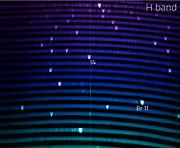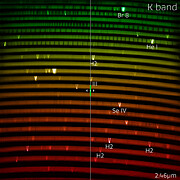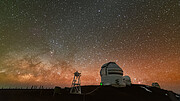Gemini North Peers Deeper Into the Dust with New Instrument
IGRINS-2, a new high-resolution near-infrared spectrograph on Gemini North, sees First Light
13 November 2023
Gemini North, one half of the International Gemini Observatory operated by NSF NOIRLab, is now peering deeper into the dusty dwellings of young stars with its new IGRINS-2 instrument. This next-generation spectrograph is an upgraded version of the high-demand visiting instrument IGRINS on Gemini South that will expand our understanding of cosmic objects shrouded by dust and gas.
IGRINS-2 (Immersion GRating INfrared Spectrograph-2) has set its ‘eyes’ on the sky for the first time. Mounted on the Gemini North telescope, one half of the International Gemini Observatory operated by NSF NOIRLab, the new instrument obtained spectra of the planetary nebula NGC 7027, nicknamed the Jewel Bug Nebula. NGC 7027 is one of the visually brightest planetary nebulae, and its resplendent rosette — made of layers of gas ejected during the dying breaths of its central star — makes for an exciting first light target.
Spectrographs are arguably the most important science instruments in all of astronomy. Unlike high-resolution cameras that capture amazing details of distant stars, galaxies and nebulae, spectrographs precisely analyze the spectrum of light emitted by these objects, revealing detailed information about their chemical composition. The expansion of NGC 7027’s dynamic gasses out into the surrounding space produces a striking spectrum that illustrates the power of the instrument.
“With the new infrared IGRINS-2 on Gemini North complementing the new optical GHOST on Gemini South, we now have two cutting-edge high-resolution spectrographs,” said Jennifer Lotz, Director of Gemini Observatory. “This expanded capability of our observatory opens up exciting windows of discovery.”
Although its first spectrum is of the death throes of a star, IGRINS-2 is actually designed to witness the first moments of nascent stars. “The main science goal of IGRINS-2 is observing young stars being born inside a dusty environment,” said IGRINS-2 Project Manager and Technical Representative Hwihyun Kim. While these dusty birthplaces are impenetrable to visible light, a near-infrared spectrograph like IGRINS-2 can pierce through the dust and observe young stars in their early development.
With its ability to see through gas, dust, and other opaque materials, IGRINS-2 is also well-suited to studying brown dwarfs, exoplanets, the interstellar medium and the evolution of galaxies. Not only is IGRINS-2 able to see through dust, it does so with remarkable resolution, allowing astronomers to resolve details about stellar atmospheres and the structures of galaxies.
IGRINS-2 was built by the Korea Astronomy and Space Science Institute (KASI) on behalf of the International Gemini Observatory. Initiated in March 2020, this instrument was constructed during the COVID-19 pandemic. “It has been gratifying to see our efforts come to fruition,” said KASI Principal Investigator Chan Park. “We delivered this instrument and its components without any delays — all in the middle of a global pandemic — thanks to the valiant efforts of our team and our partners at Gemini Observatory.”
During the highly-anticipated first-light event, excitement filled the Gemini North control room as IGRINS-2 captured its first spectra. “It’s difficult to describe the emotion of people when they saw the first observations; it was a mix of excitement, awe, relief, and joy,” said Ruben Diaz, Gemini’s acting Associate Director of Development. Kim adds that she was told by her Gemini North colleagues they had never seen so many people in the control room at one time.
Following this significant milestone, the KASI and Gemini teams will begin integrating IGRINS-2 with the software and subsystems at Gemini North, a process that will take several months. Gemini staff will then be trained in maintaining and operating the instrument. In addition, documentation will be developed to assist the user community with the instrument. IGRINS-2 will be available for use by the broader astronomy community in the second half of 2024.
“The ability of IGRINS-2 to peer within otherwise opaque regions of the Universe will allow us to better understand how stars are born and many other astronomical phenomena hidden behind galactic dust,” said Martin Still, NSF Program Director for the International Gemini Observatory. “NSF congratulates our Gemini partner, KASI, and the entire telescope staff for achieving the critical milestone of IGRINS-2 first light.”
More information
NSF NOIRLab (National Optical-Infrared Astronomy Research Laboratory), the US center for ground-based optical-infrared astronomy, operates the International Gemini Observatory (a facility of NSF, NRC–Canada, ANID–Chile, MCTIC–Brazil, MINCyT–Argentina, and KASI–Republic of Korea), Kitt Peak National Observatory (KPNO), Cerro Tololo Inter-American Observatory (CTIO), the Community Science and Data Center (CSDC), and Vera C. Rubin Observatory (operated in cooperation with the Department of Energy’s SLAC National Accelerator Laboratory). It is managed by the Association of Universities for Research in Astronomy (AURA) under a cooperative agreement with NSF and is headquartered in Tucson, Arizona. The astronomical community is honored to have the opportunity to conduct astronomical research on Iolkam Du’ag (Kitt Peak) in Arizona, on Maunakea in Hawai‘i, and on Cerro Tololo and Cerro Pachón in Chile. We recognize and acknowledge the very significant cultural role and reverence that these sites have to the Tohono O’odham Nation, to the Native Hawaiian community, and to the local communities in Chile, respectively.
Contacts
Jennifer Lotz
Director, International Gemini Observatory
Email: jennifer.lotz@noirlab.edu
Ruben Diaz
Head of Instrumentation, International Gemini Observatory
Email: ruben.diaz@noirlab.edu
Hwihyun Kim
Instrumentation Program Scientist, International Gemini Observatory
Email: hwihyun.kim@noirlab.edu
Josie Fenske
NSF NOIRLab Communications
Email: josie.fenske@noirlab.edu













